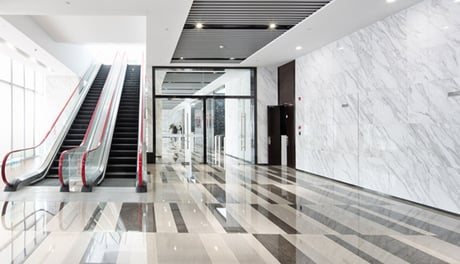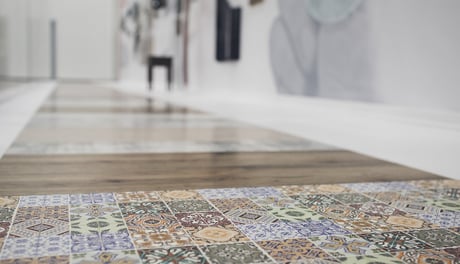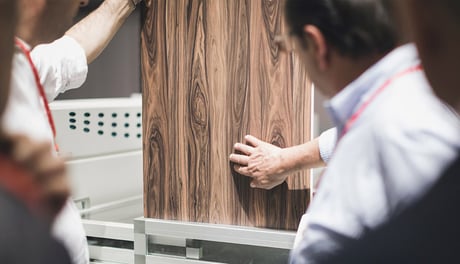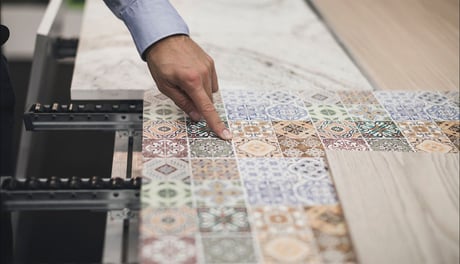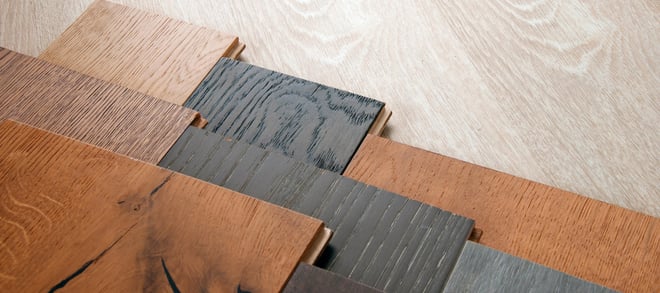
Floor decoration and digital printing: a combination that is still seldom used in the finishing sector but has enormous potential. As we know, floors can be challenging surfaces to work with. Industrial digital printing technologies provide manufacturers with valuable support by delivering high-quality, customised products able to withstand foot traffic. This last aspect is particularly relevant, as abrasion resistance is regulated by international standards that define the compliance of each product.
What does digital printing mean for flooring?
Firstly: why install an industrial digital printing machine? Let's start by saying that industrial digital printing is a versatile, innovative floor decoration solution. It allows the application of designs, motifs and images directly on the flooring materials.
The technology doesn’t just guarantee an ultra-high resolution printing process: it also reproduces vivid colours and complex details, allowing businesses and property owners to decorate their surroundings with unique images.
Whether used to create high-impact graphic design in retail areas, personalised patterns in residential interiors or branding elements in corporate offices, digital printing for floors can, in combination with tried and tested finishing technologies and innovative texturing technologies, produce durable, high-quality finishes that withstand foot traffic and long-term wear.
Furthermore, compared to traditional solutions, industrial digital printing is more sustainable as it wastes less material and allows manufacturers to change the design without having to resort to lengthy plant set-up procedures.
THE MOST INNOVATIVE FINISHING SOLUTIONS
Discover how highly advanced finishing solutions can sharpen your competitiveness.
How digital printing on floors is performed
Where used in floor-making processes, industrial digital printing is part of a rather complex production process. In general, the perfect surface finishing cycle involves six-steps:
- Sealing (in the case of MDF) or adhesion enhancement (for plastic substrates)
- White layers
- Digital printing
- Wear layer
- Textured layer
- Finishing layer.
What are the advantages of digital printing for floors?
Digitally printed floor decoration offers a series of advantages: from large-scale batch customisation to high output rates, from excellent aesthetic quality to the ultra-fast conversion of ideas into finished products, plus the ability to reproduce natural materials with precision. Let’s now explore the topic in more detail.
High levels of customisation
Unlike traditional techniques - which involve cumbersome set-ups and have limited design capabilities - digital printing lets manufacturers create unique, customised designs that respond to customers’ specific needs. This is particularly advantageous in the flooring industry, where consumer preferences are shifting towards ever-wider colour ranges and high-definition patterns and textures that seek to replicate natural materials such as wood or stone.
Sustainability and waste reduction
In general, industrial digital printing helps make production processes more sustainable. Traditional printing methods often waste considerable amounts of ink and material, especially during design changeover, set-up and cleaning tasks. Digital printing, instead, uses only the quantities of ink and materials needed for each job, significantly reducing waste.
Cost efficiency
Compared to traditional methods, industrial digital printing technology may require a higher initial investment outlay but the long-term savings will be substantial. Less waste, minimised set-up times and simplified production processes all help reduce operating costs. What’s more, the ability to perform short production runs lessens the financial risk for manufacturers who want to test new designs or products on the market.
High-quality results
Digital printing technology is synonymous with high resolution and precision. This ensures floor designs are rendered with the utmost clarity and detail. The depth of colour and precision of the intricate patterns enhance overall final product quality, meeting the needs of an increasingly demanding market that wants both high-grade aesthetics and durability.
Simplified workflows and easy integration
Another advantage of digital printing in floor finishing is that it can be integrated into existing workflows with ease. Advanced digital printing systems can be incorporated seamlessly into production processes, minimising downtime and interruptions: a crucial factor for a better-organised production line which, in turn, delivers tip-top efficiency and streamlines communication between the design and production teams.
Improved durability and performance
Industrial digital printing technology delivers tangible advantages not just aesthetically but also in terms of finished product performance. Manufacturers can, in fact, rely on digital inks that are designed to be more durable and more resistant to fading and other environmental factors. This means that floors finished with digitally printed designs maintain their original appearance and integrity over time, offering lasting value to consumers and businesses.
Inherent flexibility and time savings
A key advantage of this technology is its exceptional flexibility in response to changing market trends. Even with small batches - which require frequent set-ups - the ability to adjust the lines quickly saves time and resources, minimising the stock of semi-finished products.
Durability: a key factor
As mentioned, resistance to foot traffic is a crucial factor when selecting a floor finishing solution. The risk of surface deterioration is particularly high in areas such as hotel foyers, corridors, offices, showrooms, schools and retail outlets where there is a constant flow of people.
In these cases, flooring durability is regulated by the EN 15468 and EN 13329 standards that apply to laminate flooring.
Coating products that are used in combination with the industrial digital printing process and are intended for the flooring sector must comply with abrasion resistance class AC5 (hotel halls, corridors, offices). Moreover, more and more coatings employed in combination with industrial digital printing fall, in full, within ‘class of use 33’ for areas with intense foot traffic (large offices, shops).
This is why Cefla Finishing, in designing digital printing solutions for floors, has carried out and passed all the tests required by the regulation, in compliance with AC4 and AC5 (Abrasion Criteria) standards for digitally printed products.
Practical digital printing applications for floors
The floor-making process is largely designed to meet the needs of the market for indoor products, most of which are used in retail and residential construction projects.
Nevertheless, specific applications for outdoor flooring surfaces also exist: for example, decking is ideal for those who need to set up showrooms or trade fair stands, public areas with high levels of pedestrian traffic or shared open-air areas in residential and hotel settings.
Inks for digital printing of floors: organic vs inorganic
Note, however, that the type of ink used in the digital printing process needs to be selected with care as consumables, in fact, determine the long-term aesthetic quality and durability of the flooring.
Organic pigmented inks, for example, tend to fade. Outdoors, colours tend to deteriorate during the first two years of exposure to natural light unless special anti-UV coatings are applied.
Fortunately, inorganic inks with metal oxide pigments - which will remain virtually unaltered by light for more than ten years - can be used.
So, while organic pigmented inks are perfect for indoor use (and certain outdoor areas if adequately protected against UV damage), inorganic pigmented inks are a good choice for outdoor applications, such as decking.
Innovations in digital printing for flooring
Lastly, industrial digital printing improves floor finishing processes by employing highly innovative techniques. Just think of texturing. By producing surfaces with dense relief patterns or tiny marks, texturing completes the sensory experience from both tactile and visual standpoints. This is crucial for success on the décor market, where the goal is to obtain prints that realistically reproduce natural materials.
In short, thanks to digital printing, the only limits are those posed by your imagination.
LOOKING FOR THE IDEAL COATING LINE SOLUTION?


